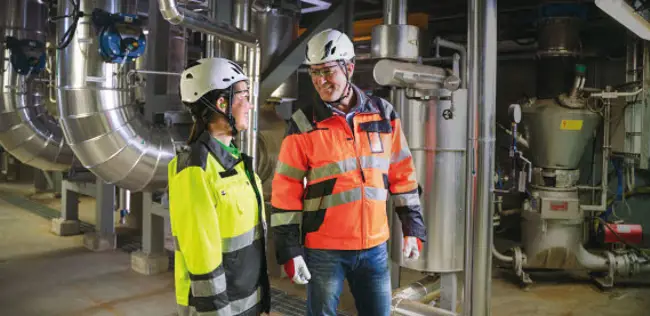Decarbonizing with breakthrough technologies
Jun 17, 2022
Increasing energy efficiency and reducing greenhouse gas emissions have been long-term targets for the forest industry. However, the rising energy prices and the ever more stringent need to stop climate change are boosting companies in finding even more efficient solutions. This is where technological innovations have a key role.

Jori Ringman, Director General of the European association representing the paper industry (Cepi), confirms that reducing CO2 emissions through technological improvements and replacing fossil fuels with renewables in energy production are trending globally. The pressure is coming both from the markets and from legislation.
“The EU has set a binding target of achieving climate neutrality by 2050 as part of the European Green Deal. The goal requires current greenhouse gas emissions to fall in the coming years.”
Societies won’t provide quick solutions, so we must find them in the value chains with our suppliers.
Additionally, the EU has made its 2030 climate target more ambitious. It is now seeking to cut emissions by an average of at least 55 percent in the economy by 2030 compared to 1990. The bar is set even higher for the pulp and paper industry – up to 61 percent by 2030 compared to 2005.
According to Ringman, the pulp and paper industry is the most advanced in the EU ETS sector, with the highest emission reductions. “Since 2005, we’ve decreased our CO2 emissions by 29 percent. But we still have plenty of work to do to reach our final target.”
He notes that during its nearly 20-year existence, the EU’s Emission Trading Scheme has undergone several revisions to align with the overarching EU climate policy objectives. This permanent state of change means we cannot be sure about policies and legislation.
“The EU is executing a very ambitious climate policy but isn’t offering solutions for how to do the work in practice. European industries and businesses must find the answers themselves,” adds Ringman.
Ultimately, the main question concerns whether European policy encourages industrial activities and investment.
The share of renewable and clean energy production is gradually increasing, but we must find other solutions before then.
“We must find new ways to work so that companies will continue to develop their businesses in Europe. In this respect, companies like Valmet are an essential part of the value chain, providing future-proof technologies that enable investment.”
Consumers raise the barrier
Ringman emphasizes that the entire value chain has become more aware of CO2 emission and energy issues. Markets have become an especially significant driver of the change. The input from consumers and end users is more evident than ever.
“There’s genuine interest in the downstream of the paper industry in switching to low-impact materials like paper and other sustainable products.”
He adds that wood-based textile fibers are an excellent example of new forest industry products that could reduce the environmental impact.
 |
Ringman emphasizes that the entire value chain has become more aware of CO2 emission and energy issues. Markets have become an especially significant driver of the change. The input from consumers and end users is more evident than ever. |
“Wood-based textile fibers have better climate impacts and don’t generate microplastics. They don’t compete with food production or need fossil pesticides and fertilizers. Even finishing textiles with food fibers is easier and reduces chemical use, and we now have technologies to make these textiles recyclable!”
On the other hand, packaging made with paper and board is already a circularity champion but is still improving recycling.
“As a biodegradable material, the environmental impact in the case of accidental littering of paper and board is less significant than that of other materials. And the carbon footprint is continuing to reduce, whereas with the main competing packaging materials, the trend is the opposite.”
Looking for innovations
Ringman confirms that the pulp and paper industry has been doing constant R&D work to find new solutions for the future. One prospect is to fabricate paper without water.
Paper mills use a lot of water to ensure paper quality. At the same time, the machines consume a lot of energy, because they must remove the moisture and dry the paper. “We hope to make this breakthrough by 2050. However, we can’t wait that long, so we’re already using existing technologies to save energy and decarbonize the industry.”
Part of the answer is to exploit all residues more efficiently. Thanks to growing energy efficiency, sidestreams previously used for energy production can now be turned into new value-added materials.
“For example, we can use lignin to replace graphene in electric car batteries. The option is already available there. We can also avoid other serious problems like environmental pollution or even the use of child labor in the mining of graphene.”
Ringman predicts there will be more diversity in the raw materials used in the paper industry. Besides pulp, paper mills will use other cellulose-based raw materials like agriculture waste streams or even old textiles. Production will also diversify, with more and higher value-added products from the same factory in the future.
Competition for clean energy
Economic activity is recovering from the pandemic, and production is surging to its former levels. At the same time, the clean energy offer is growing only gradually, and energy prices are likely to remain high.
“The apparent trend is that energy prices will remain much higher than we were used to in the past. The green transition will squeeze the carbon economy and bring a lasting cost increase in energy production. The scarcity of clean energy will persist with every economic activity’s rapidly growing demand for it.”
Ringman predicts there will be fierce competition in carbon neutral energy. “Societies won’t provide quick solutions, so we must find them in the value chains with our suppliers.”
Cepi has been organizing monthly cross-industrial sessions to identify the already available opportunities. “For example, we’ve been investigating whether industrial heat pumps could be an energy-saving option. Another issue concerns how much solar energy we could produce and use in pulp and paper mills.”
He confirms that carbon leakage is a real issue. Investments have not significantly increased outside the continent, but competitors have identified the increasing production costs in Europe as an opportunity.
“We’re one of the most affected carbon leakage industries. Due to EU legislation and regulations, our production is also more expensive. And while EU markets have been open for pulp and paper imports since 2004, we’re facing a lot of trade barriers to our exports. But as we’re still a net exporting region, this means we have some other strengths to help us stay competitive.”
“There’s no silver bullet for tackling the greenhouse gas problem. Increasing energy efficiency and CO2-free energy production are the main steps. The share of renewable and clean energy production is gradually increasing, but we must find other solutions before then. All the solutions Valmet offers in decarbonization and energy saving are worth their weight in gold,” Ringman concludes.
Text Vesa Puoskari
Photos Cepi and Timo Marttila
Related articles

